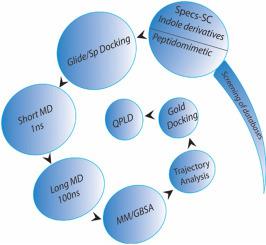Journal of Molecular Graphics and Modelling ( IF 2.9 ) Pub Date : 2021-02-25 , DOI: 10.1016/j.jmgm.2021.107876 Saima Ikram 1 , Fawad Ahmad 2 , Jamshaid Ahmad 2 , Serdar Durdagi 3

|
Granzymes are serine proteases synthesized by CTL and NK cells. Five granzyme genes (GzmA, -B, -H, -K, -M) are present in humans, which are located at three different chromosomal loci. Being serine proteases, the binding pocket constitutes a catalytic triad (i.e., His59, Asp103 and Ser197). Granzymes are released into target (cancerous and virally infected) cells by a specialized process known as granule exocytosis pathway. After internalization, these proteases initiate apoptosis. Granzymes are also involved in other non-apoptotic immune associated roles like ECM remodeling, cytokine modulation, killing of pathogens through generation of phagosomes. Their intracellular activity is regulated by specialized inhibitors knows as SERPINs. However, if these proteases are secreted in excess into the extracellular environment, their regulation becomes important as otherwise they start self-damage to the tissues thereby worsening the disease conditions. Efforts are being made to identify potential inhibitors for regulation of these proteases in an extracellular environment. Physiological and synthetic inhibitors have been reported against some members however there is no known inhibitor against extracellular human GzmH. Thus, in the current study, we investigated small molecule databases for the identification of potential molecules having the ability to inhibit GzmH by combined molecular simulations, which can ultimately be used as a potential therapeutic agent.
中文翻译:

使用结合的文本挖掘,基于配体和靶标驱动的方法鉴定小颗粒酶H抑制剂的小分子文库的筛选
颗粒酶是由CTL和NK细胞合成的丝氨酸蛋白酶。人类中存在五个颗粒酶基因(GzmA,-B,-H,-K,-M),它们位于三个不同的染色体基因座上。作为丝氨酸蛋白酶,结合口袋构成催化三联体(即,His59,Asp103和Ser197)。颗粒酶通过称为颗粒胞吐途径的专门过程释放到靶细胞(癌和病毒感染的细胞)中。内化后,这些蛋白酶启动细胞凋亡。颗粒酶还参与其他与细胞凋亡无关的免疫相关作用,例如ECM重塑,细胞因子调节,通过吞噬体杀灭病原体。它们的细胞内活性受称为SERPINs的专门抑制剂调节。但是,如果这些蛋白酶过量分泌到细胞外环境中,它们的调节变得很重要,因为否则它们会开始自损坏组织,从而使疾病状况恶化。人们正在努力寻找在细胞外环境中调节这些蛋白酶的潜在抑制剂。已经报道了针对某些成员的生理和合成抑制剂,但是没有已知的针对细胞外人GzmH的抑制剂。因此,在当前的研究中,我们研究了小分子数据库,以通过组合分子模拟来鉴定具有抑制GzmH能力的潜在分子,这些分子最终可以用作潜在的治疗剂。人们正在努力寻找在细胞外环境中调节这些蛋白酶的潜在抑制剂。已经报道了针对某些成员的生理和合成抑制剂,但是没有已知的针对细胞外人GzmH的抑制剂。因此,在当前的研究中,我们研究了小分子数据库,以通过组合分子模拟来鉴定具有抑制GzmH能力的潜在分子,这些分子最终可以用作潜在的治疗剂。人们正在努力寻找在细胞外环境中调节这些蛋白酶的潜在抑制剂。已经报道了针对某些成员的生理和合成抑制剂,但是没有已知的针对细胞外人GzmH的抑制剂。因此,在当前的研究中,我们研究了小分子数据库,以通过组合分子模拟来鉴定具有抑制GzmH能力的潜在分子,这些分子最终可以用作潜在的治疗剂。



























 京公网安备 11010802027423号
京公网安备 11010802027423号